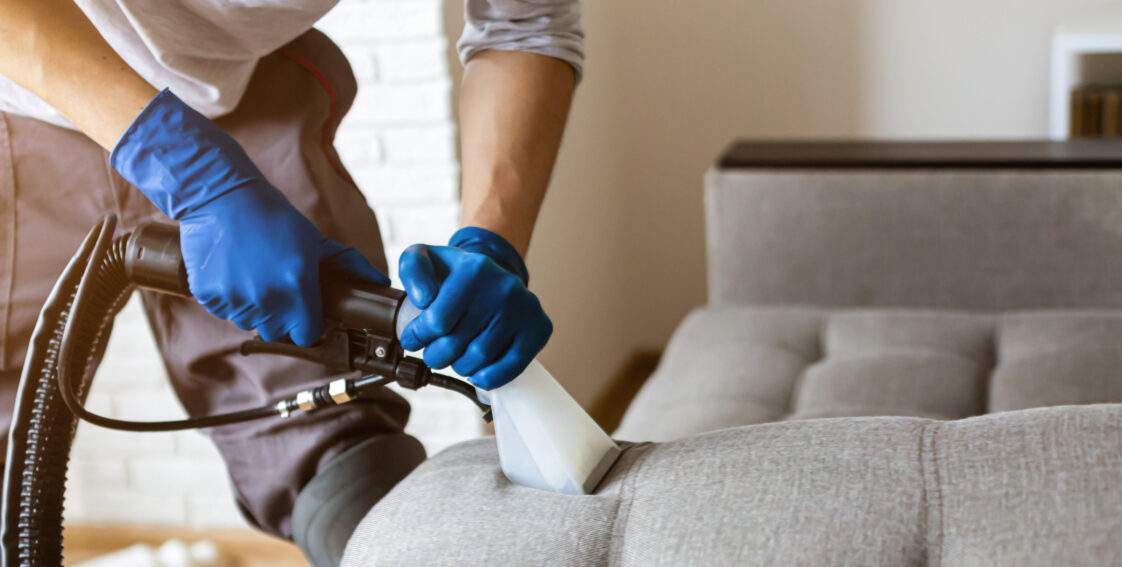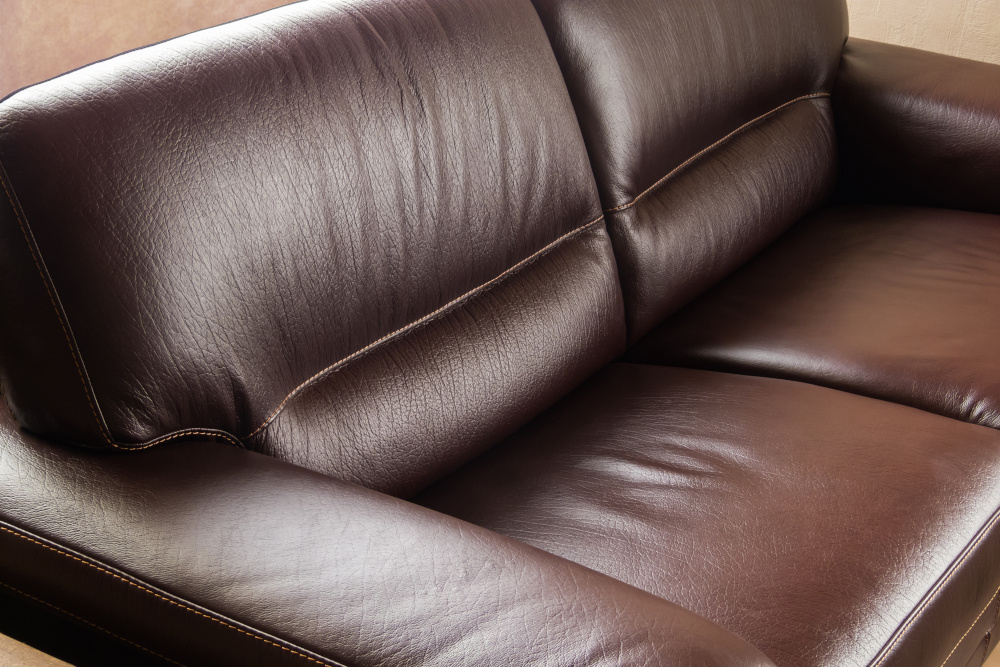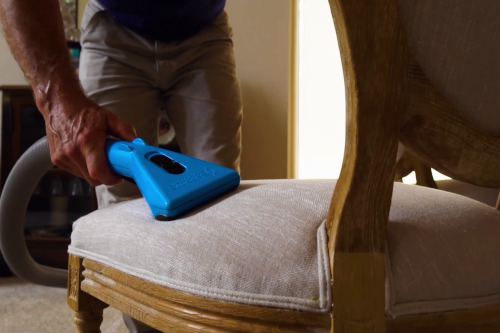
Upholstery Cleaning Schedule
- Residential Furniture/Upholstery
- Commercial & High-Traffic Upholstery
- Recommended Maintenance Frequency by Material
- Maintain Your Upholstery
Upholstery maintenance is an often overlooked but critical part of keeping your office and home presentable and welcoming. Stains and odors on your furniture will make a lasting impression on your customers and guests, but not a good one.
Generally, you should schedule professional upholstery cleaning at least once a year. However, when to clean your furniture can fluctuate depending on how often it’s used, the environment it’s stored in, and the material it’s constructed from.
Read on to learn more about some of the nuances of upholstery cleaning.
Residential Furniture/Upholstery

- Brush & Vacuum Furniture Once a Month: Bacteria, pet dander, dust, dirt, and other allergens within couches and chairs build up over time. Vacuuming and brushing regularly reduces this buildup. If you’re removing stubborn pet fur, try a microfiber cloth instead of a lint roller, as the adhesive on some residential rollers can damage the fabric. If you have a multi-pet household, you may want to increase the brushing and vacuuming to once per week, depending on how much fur accumulates on your furniture.
- Deep Clean Annually: If you have children, you may want to deep clean your furniture more frequently. Generally, when you notice stains on your furniture, you should clean them immediately. When removing stubborn stains, always pay close attention to the upholstery codes.
- Always Pay Attention to Upholstery Cleaning Codes: You will need to consult the upholstery code on the furniture label to determine how to clean the furniture. If you can’t find the label, please read the ‘Recommended Maintenance Frequency by Material’ section. The primary upholstery codes are W (wet), S (solvent), WS (wet and solvent), X (vacuum), and D (dry clean). W means you should only spot clean with distilled water. S means you should dry clean the furniture with a solvent-based product. WS means you can use wet- and solvent-based cleaning methods. X indicates the furniture cannot be deep cleaned, only vacuumed or brushed. D means dry clean only.
Commercial & High-Traffic Upholstery
Preventative maintenance is key to keeping commercial upholstery and furniture clean and fresh. However, not all of your upholstery will experience the same use. The key is to identify the upholstery that should be professionally cleaned more often than others based on how often it’s used.
- Define High-, Medium-, & Low-Traffic Furniture: Start by categorizing your furniture into three groups: high-traffic, medium-traffic, and low-traffic. A preventative maintenance schedule can then be put together based on these categories.
- Clean High-Traffic Furniture Monthly at Minimum: Upholstered furniture placed within a high-traffic hallway or beside a lunchroom should be categorized as high-traffic/high-use and would, therefore, require more frequent professional cleaning. Depending on how high the usage is, they could be cleaned monthly or bi-monthly. Hotel room furniture is one example where a professional deep clean is needed weekly, bi-weekly, or monthly, given how often the upholstery is used.
- Clean Medium-Traffic Furniture Every Three Months: Medium-traffic furniture may include a chair of an employee who often travels or works at home most of the time. Other examples are lesser-used meeting rooms, conference rooms, rear entrances, and lower-traffic hallways. Upholstery in these areas may only need professional cleaning every three months or semi-annually.
- Clean Low-Traffic Furniture Bi-Annually: Low-traffic furniture should be any furniture in areas that customers and employees rarely, if ever, use. It can include a portion of your business you’re not currently using, such as unused offices and rooms. These don’t need to be cleaned as often.
- Vacuum Furniture Once Per Month: Regardless of use, all furniture should be at least vacuumed and brushed once per month. Even if the furniture isn’t used often, dust will still accumulate.
Recommended Maintenance Frequency by Material
Cleaning different upholstery on your own can be problematic, as mistakes are often made when matching cleaning agents to fabric. Before cleaning your furniture, check the upholstery code on the label to see the recommended method. If you can’t find a label, please follow these general guidelines:
Leather

- Dust Once Per Week: Slightly dampen a microfiber cloth with distilled water and wipe away any debris and dirt.
- Deep Clean Every Three to Four Months: The frequency may need to be adjusted based on your environment. Never use polishes, abrasives, varnish, unknown liquids, or cleaning solvents on leather. The safest method is to use a combination of two teaspoons of mild dish soap and several cups of water. You can safely use this mixture to wipe down leather as needed. If you notice small stains, you can spot-clean them.
- Condition Every Annually or Bi-Annually: Leather is a porous material. Routine conditioning prevents the material from drying out. You will need to buy a specialized leather conditioner and follow the manufacturer’s instructions. If you need to clean your leather furniture more frequently, you must also increase conditioning.
Natural Fibers

- Vacuum/Brush Every Week: Vacuuming and brushing are especially important if you have pets, as fur and dander can easily cling to upholstered furniture made with natural fiber materials. Use the upholstery attachment on your vacuum to lightly clean the furniture.
- Deep Clean Every One to Two Years: Natural fibers only need to be deep cleaned every one to two years. These materials are extremely delicate, so hiring a professional is recommended. If you don’t hire an upholstery cleaner, you must find a cleaner specially designed for natural fibers. When cleaning your furniture, ensure you’re not oversaturating the material, as it can cause water stains and shrinkage.
- Spot Clean When Needed: If you notice a stain, it’s best to treat it as soon as possible. You can use a mild detergent or a natural fiber cleaner to treat the stain. Always perform a small spot test before using any cleaning solution.
Microfiber
- Vacuum Every Week: Use the upholstery attachment on your vacuum to clean microfiber furniture.
- Deep Clean Every Three to Six Months: The frequency may need to be adjusted based on how often the furniture is used. You will need to use a mild soap solution or a cleaner specifically designed for microfiber and a soft brush. Like cleaning natural fibers, you don’t want to oversaturate microfiber.
- Spot Clean As Needed: When stains appear, use a damp cloth or baby wipe to clean small stains and dirt. For stronger stains, use a specialty microfiber cleaner or a mild soap solution.
- Deodorize As Needed: Microfiber materials easily trap odor. If you’ve noticed unpleasant smells, sprinkle baking soda on the fabric and let it sit for 2-3 hours. Then, clean the couch with a vacuum.
Velvet
- Vacuum Every Week: Use the soft brush attachment on your vacuum to remove any dust and lint. Dust, pet dander, and pet fur can easily attach to velvet, so you may want to increase the frequency if you’re a multi-pet household.
- Deep Clean Annually: You don’t want to try to clean velvet furniture on your own. Velvet tends to mat during cleaning, and there are many cleaning solutions you can’t use on velvet. If you can’t hire a professional, find a cleaner specifically made for synthetic or wool-based velvets, and be sure to use a soft brush or velvet upholstery brush. When cleaning, always move the brush in the direction of the grain—going against the grain could damage the fabric.
- Spot Clean Immediately: If you notice a stain, dampen a chamois cloth and wipe the stain. Again, always go with the grain. If it’s a stubborn stain, use the specialized velvet cleaner to spot-clean.
Polyester & Other Synthetic Fibers
- Vacuum Weekly: Use the upholstery attachment on your vacuum to suck up any dust, lint, fur, or dander that may have accumulated on your furniture.
- Deep Clean Annually or Bi-Annually: Match your cleaning agent to the upholstery code. If unsure, you should buy a cleaner designed for synthetic fabrics. You can also use a steam cleaner designed for synthetic fabrics or create a mild solution with white vinegar, several cups of water, and a small spoonful of laundry detergent. Test a small area first before moving forward. If the furniture is in a high- or medium-traffic area or is highly used, clean it bi-annually; if it’s not frequently used, clean it annually.
- Deodorize Monthly or More: Synthetic fabrics can also quickly become odorous. You can neutralize odors with a fabric freshener or baking soda (see the Microfiber section above for more information).
Maintain Your Upholstery With Help From DuoCare
Your furniture is an investment. Protect it by having a professional routinely vacuum and deep clean it.
For over 40 years, Duo Care has helped countless homeowners and businesses in Michigan with professional upholstery cleaning services. Our team can even set up a maintenance plan for you so you know exactly when your next cleaning is due.
Contact us today to learn more about our service capabilities or to schedule your next upholstery cleaning.
